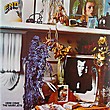|
|

From head to heart Following our retroscope series of latter years, here we go again! Here's Speakers' corner's cousin; From head to heart. Luna Kafé's focused eye on great events, fantastic happenings, absolute milestones, or other curious incidents from the historic shelves'n'vaults of pop'n'rock. Blowing our ears and our head, punching our chest and shaking our heart. Making us go sentimental, but not slaphappy. This moonth the Lunar time-machine juke-box revisits a debut solo album from January 1974. It's an album made by a true wizard of sound, from the art and glam division of rock, including weird and wild hairdos and clothing. With flamboyance, elegance and ambience being key-words for his career. He's been involved with/worked with/collaborated with, and/or recorded/produced music for a long line of bands and artists, from Roxy Music and Robert Fripp, via David Bowie and Talking Heads, Ultravox! and Devo, James and U2, John Cale and Robert Wyatt, Slowdive, Laurie Anderson, Coldplay, Paul Simon, Grace Jones, Sinéad O'Connor, James Blake, and many, many more. His most played composition is the 3.8 seconds Windows95 start-up sound. As he answered when Microsoft asked him if he did use a PC for the job: 'No I wrote it on a Mac. I've never used a PC in my life; I don't like them.'
Brian Eno Most people probably think of Brian Peter George St. John le Baptist de la Salle Eno as the profiled producer of the most successful albums by U2 and Talking Heads, even one by Coldplay, and collaborator on Bowie's most groundbreaking albums in the second half of the 1970s. Others consider him the foremost ambient innovator and the man behind other kinds of experimental instrumental music, including his duo projects with Robert Fripp, Harold Budd, David Byrne, ... He has also been involved in musical projects and albums with John Cale, Kevin Ayers, Nico, Robert Wyatt, Genesis, Cluster, Devo, Laurie Anderson, Jon Hassell, Philip Glass, Gavin Bryars, Daniel Lanois, Ultravox, Depeche Mode, Massive Attack, Grace Jones, James and Portsmouth Sinfonia (that consisted of persons that hadn't learned to play their instruments and at least held one infamous concert at the Royal Albert Hall, in the foyer) to name but some. In more recent years, Eno is probably most renowned for his art installations involving video and music/sound. We mustn't forget that he was the original synthesizer player of Roxy Music and participated on the band's first two albums. He also ought to be remembered for his first song-based solo albums. His solo album debut was released 40 years ago this very moonth. And what a delight! Here Come The Warm Jets includes at least one part Velvet Underground rock'n'roll, add a little Syd Barrett solo era eccentricity, ditto Eno's own eccentricities, some glam rock, art rock and even some pure pop and there we are. With a little less eccentricities and original ideas, including some noisy ones, Eno might have continued his status as a glam rock star. Mind, Roxy Music was the next big thing when Eno was on board, rising stars when glam rock was the hottest kind within rock and pop in Britain, along with Marc Bolan and his T. Rex, Bowie of the Ziggy Stardust period, The Sweet, Slade, Gary Glitter and others, even Elton John. It was allegedly Eno who said the famous phrase about the album The Velvet Underground & Nico that not too many people bought it initially, but everyone who did, were inspired by it and started a band. Well, Eno certainly did, at least he joined Roxy Music early on. And he certainly was inspired. The opening track of Here Come The Warm Jets "Needles In The Camel's Eye", written along with Roxy's ace guitarist Phil Manzanera, seems to be Eno's quite alternative version of the opening track of Velvet's debut "Sunday Morning". Phil's guitars are more dominating and has a quite different flavour compared to Velvet's. The same goes for Eno's characteristic pointed and a bit nasal voice. The melody eventually wanders somewhat off the "Sunday Morning" track, but the inspiration is still there. It also seems to be a forerunner for Bowie's "Heroes" (the title track off his second 1977 album, written in collaboration with Eno incidentally). "Cindy Tells Me" is a title that no one but Lou Reed could have come up with, well, apart from from Eno and Manzanera, obviously. It's a nice pop song with a slight reggae vibe, but spiced with some synthesizer noise quite early on and a couple of sharp guitar solos off the trodden path that elegantly put a stop for any potential hit single speculations. "Baby's On Fire" is probably the closest to a hit off the album. At least it was a live favourite, represented on a couple of albums a few months (June 1, 1974, mainly a Kevin Ayers album) and years (801 Live, a side project by Manzanera) later. It's wrapped as glitter rock material, but basically it's a simple two chord song, so easy that even yours truly performed a version of the song live once. If the it had been played a bit faster and with a much shorter and focused guitar solo, the song would've fitted nicely as proto punk material. "Driving Me Backwards" is another favourite, basically a simple piano driven pop song turned into art pop with some backwards sounding effects. I cannot say if anything really is played backwards here, but both vocals, beats and maybe even parts of that sharp guitar walking in and out of the song might be. Anyway, the result is some strange drone'ish ditty, the most fascinating of the entire album. Here are some songs closer to straighter clean cut pop, too. On "On Some Faraway Beach" there even are some languishing strings involved whereas "Some Of Them Are Old" includes very harmonic backing vocals, probably by the man himself. They're both spiced with a drop or two of melancholia. Our hero didn't want to keep to the well trodden path all the way, though. On the former, his vocals don't join in before 2/3 into the track and the latter includes a strange Hawaiian-sounding slide guitar solo. "The Paw Paw Negro Blowtorch" starts as a very merry pop song but soon turns leftfield with a hilarious synth solo (let's have fun with bleeps!) and an instrumental maelstrom lead by a flangered bass guitar. The title track is probably the weakest of the lot and includes some hardly audible lyrics. The title might mean urinating, but Eno stated in an interview that it describes the strange sound of the guitar on the track, played, as far as I reckon, by the non-musician Eno himself. Quite fascinating, it sounds almost like a bumble bee, if you ask me. "Dead Finks Don't Talk" is another harmonious pop song that is gradually perverted by more and more disharmonic backing vocals and a nasty synthesizer solo, sort of, at the end. Great! "Blank Frank" written with buddy Robert Fripp is nasty all the way through, mainly because of the latter's razor and noise guitars all over the place. One thing is clear: Eno makes the statement that he doesn't want to be a pop star! And with tongue firmly in cheek. This include the lyrics, too. They are a combination of clever and funny observations, some with double, triple or dubious meanings. Here is one obvious example: Baby's on fire Oh driving me backwards Perhaps you think that I'm lazy Meet my relations All of them grinning like facepacks The album charted on both sides of the Atlantic, though, reached as far as no. 26 in the British charts. His highest position with a solo album, I suspect. The man followed up with one more albums of funny and hilarious songs before he was hospitalised and started to philosophy about background sounds/music, ambient as he called it. His third Another Green World (1975) and fifth Before And After Science (1977) were the transition albums with a mix of song based and instrumental/ambient tracks. In between them he released his first completely ambient album Discreet Music. Eno hasn't completely left the world of song based numbers under his own banner. For instance his duo album with John Cale, Wrong Way Up, from 1990 is highly recommended though it was a struggle to complete on both parts. As recently as in 2005 he released Another Day On Earth, a pleasant song based album, though more relaxed and less humorous than his first two solo albums. If you want to dig deeper into the unexpected career moves of the man, there is no better starting point of his vocal efforts than Here Come The Warm Jets. Copyright © 2014 JP
|
| You may also want to check out our Brian Eno article/review: Reflection. |
| © 2014 Luna Kafé |
